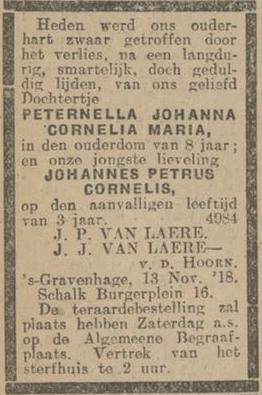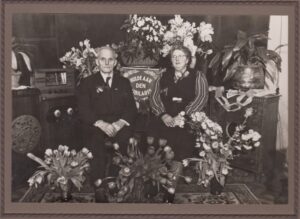My father-in-law, Pierre van Laeré, often told the story of the tragedy in his family: “During the Spanish flu epidemic, my parents lost a daughter and a son in a single night.” A little bit of research reveals the harsh reality of the effects of this pandemic.
Spanish flu
At the beginning of 1918, the last year of the First World War, the first cases of what was later to be called Spanish flu became known. Those infected developed high fevers, muscle aches, sore throats and coughs. Patients also became extremely tired, so that no energy was left to eat or drink. Breathing became increasingly difficult and one could die within a few days.
The total number of deaths in the Netherlands was estimated to have been 38,000.
Spanish flu in The Hague
In the newspaper ‘Het Vaderland’ of 17 July 1918, the following report appeared: “We have been informed by the authorities that cases of Spanish flu occurred in our town a few weeks ago. At the time not much attention had been paid to this disease and the patients recovered without knowing what important persons they had been. “
The following day’s Haagsche Courant reported: “The Spanish disease is spreading; there are reports from various places of a larger or smaller number of cases. Judging by the deaths, the Spanish disease is certainly not as harmless as people in Germany would have us believe.”
Reactions
It was increasingly evident that unusual measures were needed to combat this disease. On 1 November 1918, the Municipal Executive of The Hague decided to close all public schools from 1 to 11 November. (But on the same day the Dutch Football Association (N.V.B.) announced that football clubs were not allowed to postpone their matches because of the Spanish flu. )
Many advertisements appeared in the newspapers, offering remedies that promised to prevent or cure the disease. Sample slogans: “Heal your cough with Abbey syrup!” And: “Effective remedy against Spanish flu.”
It is striking that not a single speech from the throne in that period mentioned the Spanish flu and its effects on Dutch society. This is in contrast to the throne speech of 2020, in which the government extensively discussed the corona pandemic and its consequences.
My family-in-law
At the time of the Spanish flu the Van Laeré family consisted of father and mother Johan and Johanna van Laeré with 4 children:
Peternella Johanna Cornelia Maria, called Nelly (1910);
Johanna Jacoba, called Jo (1912);
Douwe Pierre Louis, called Pierre (1914, my father-in-law)
Johannes Petrus Cornelis (1915).
Of the youngest child no so called “roepnaam”, as we say in Dutch, has survived. They lived at 16 Schalkburgerplein, a part of The Hague they would not recognise now. In the register of births, father Van Laeré was recorded as ‘tailor’ and mother as ‘without profession’.
This family’s tragedy is evident in the obituary that the parents placed in the Haagse Courant of 15 November 1918. Their ‘parental hearts’ were deeply affected by the loss of their 8-year-old first daughter and their youngest darling, their 3-year-old son.
The death certificate puts the tragic situation even more sharply into focus. Nelly died on the 13th of November 1918 at half past one in the morning and her brother died a few hours later at eight. My father-in-law, then a boy of four, could not remember much of the events. But the image of two small coffins being carried into the house and out again stayed with him all his life.
Johan and Johanna van Laeré would have three more children. One of these three girls was named Petronella Maria, for her lost sister, and her name was shortened to Nel. A generation later, in 1951, another Johannes Petrus van Laeré was born, whose “roepnaam” I do know, for I use it every day: Hans.
I will tell you more about families in The Hague during my city walks and bicycle tours.
More information about the Spanish flu in this short film.







